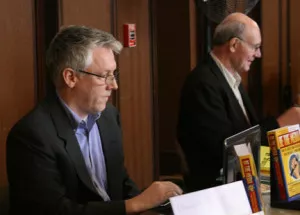
David Mathison (Photo: Paula Hendricks)
After Danny O. Snow and Scott James had finished, there were more breakout sessions. Our final speaker for the day was David Mathison, on “Using Social Media to Build Your Brand to Sell More Books.”
“Mathison is a media consultant, speaker, publisher, and hi-tech entrepreneur, with more than 25 years experience in content distribution. His new book, Be The Media, sold over 5,000 copies in just eleven days via his web site, blog, Twitter, and Facebook. From 1995-1999, Mathison was Vice President with Reuters, the world’s largest news agency, where he pioneered online content syndication. From 1999-2002, he was founder and CEO of the Kinecta Corporation, where he raised $30 million in under two years. Kinecta is now part of Oracle.”
Using Social Media to Build Your Brand to Sell More Books
Although this was the title, and the ostensible subject matter of his talk, there were far more urgent matters on the agenda that came up again and again in Mathison’s passionate presentation. Mathison is a high-energy speaker who has been at the center of some of the biggest innovations in content delivery, including the development of RSS.
His experience as a former Vice President of Global Syndication for Reuters formed part of the background of his talk, as he guided the audience into the world of digitized, deliverable content.
Mathison has stated his interest in providing more egalitarian, democratic and open systems for the delivery of news, for publication, for any content-delivery you can think of.
The Behind the Behind
(Photo: Paula Hendricks)
Looking into Mathison’s book, Be The Media, I ran across an endorsement from Steve Piersanti, President of Berrett-Koehler Publishers in San Francisco. He said, “Be The Media is the ‘Whole Earth Catalog’ for independent media.”
That clicked. Much of the subtext of Mathison’s talk was a plea for listeners to abandon the forms we had become used to thinking in, in favor of the new reality in media, the systemic change that has been initiated by digitization and all that it has spawned. The essentially peer-to-peer relationships that exist on the web are both an embodiment and a reflection of the democratic reality that has been wrought by digitization.
Self-publishing, independent music, podcasting, internet radio, ezines, syndicators of digital content, bloggers, videographers, websites, wiki sites, internet TV, social networking systems like Facebook and Twitter: these are the media being born around us now that we have entered a change time.
Even more than a revolution, which according to Mathison can be just a historical blip, we have entered a Renaissance, a much longer period of change, of acclimation to new technology and new knowledge, and then integration of those technologies into everyday life. This can take for a long time.
Practical Evangelism
(Photo: Paula Hendricks)
Mathison used the publication of his new book to illustrate many of the points he was making, and his entire presentation could be used by most self-publishers to better understand the forces at work that are changing the book business, as well as give them a direction in which to look as they move into the future.
Probably the line I remember the best from the presentation is this:
Containers are dying, Fields are thriving
As technology loosens the grip that old media has on the distribution of content, it becomes possible for people to create their own media. Mathison pointed to the music business. Music publishers had their business decimated by digitization and downloading. That is, the container—or the business model that had been used to deliver music—died. But instead of music itself dying, there is now more independent and idiosyncratic music available more easily than at any other time in history. Music itself—the field—has flourished in the hands of small independent producers.
Even more subversive, of course, is the democratic message that comes with this change. While acknowledging that old media still “writes the big checks” and has the best access to retail distribution and other major media like TV, there’s no escaping the radical message at the core of Mathison’s evangelism.
When we realize we’re in a renaissance, it’s an opportunity for social change. Renaissance changes people’s perceived relationships with power. It represents the re-birth of old ideas in a new context. Radio becomes internet radio. Music becomes downloadable mp3s. TV becomes Youtube. The containers die, the fields thrive.
What’s democratic—and where Mathison is the most persuasive—is that anyone can participate, anyone can become a content creator, a member of the “media of one.”
He pictured this change as a shift from an economy based on scarcity to one based on abundance. In the old economy, big businesses wanted only a few blockbusters to make those stars very valuable. But in the new model—the long tail model, if you will—there is more and more content that appeals to smaller and smaller demographic groups. Abundance of material is guaranteed by the explosion of creators. Instead of being dictated to by a top-down hierarchy about who will be the winners and who the losers, the crowd-sourced, Twitter-enabled, smartphone-carrying public exercises the democracy of the market, voting without anyone else’s advice for their own choices.
Similarities and Important Points
 Scott James aka Kemble Scott takes notes
Scott James aka Kemble Scott takes notes
(Photo: Paula Hendricks)
Similarly to the talks given earlier in the day, Mathison made a point of talking about how poorly big media has treated the very content creators it needs to exist. He read from a particularly oppressive contract used for the American Idol contestants, in which they basically give up any and all rights, throughout the universe, in perpetuity. Very unpleasant examples of huge corporations taking advantage of young and promising talent, always looking to “lock up” the next blockbuster.
He said that content creators have important things to watch out for:
- Learn to maintain a direct relationship with your audience
- Always maintain control of the rights to your work
- Figure out how to “re-purpose” your content, to find different ways to get your content out
Mathison included a look at the actual long tail diagram to make a terrific point near the end of his talk. Citing the Foreword to his book by Kevin Kelley, the author and co-founder of Wired magazine, Mathison points out that to succeed in this new, diversified world, you only need about 1000 true fans. This, he claims, represents the turning point on the long-tail graph, where you are leaving niche-land, but you are not a “star” or blockbuster. What’s enticing is realizing that this goal is not unreachable for many “content creators” including you and me.
Takeaway: As Mathison said, “all hell is breaking loose” in the fields of media and content distribution. The world is changing around us, and we only need to understand how it is happening in order to take hold of the tools of change for ourselves.




